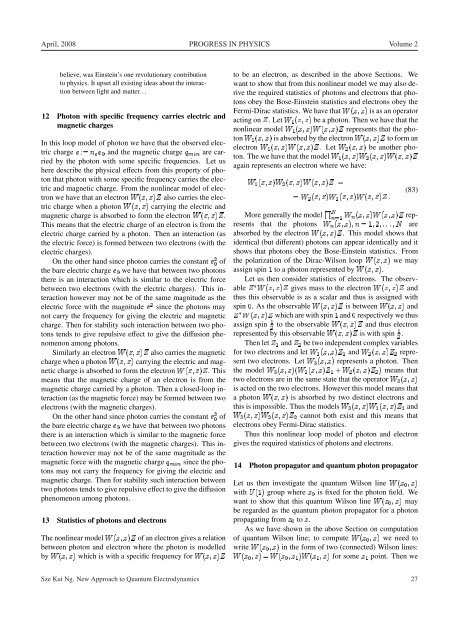Vol. 2 - The World of Mathematical Equations
Vol. 2 - The World of Mathematical Equations
Vol. 2 - The World of Mathematical Equations
Create successful ePaper yourself
Turn your PDF publications into a flip-book with our unique Google optimized e-Paper software.
April, 2008 PROGRESS IN PHYSICS <strong>Vol</strong>ume 2believe, was Einstein’s one revolutionary contributionto physics. It upset all existing ideas about the interactionbetween light and matter. . .12 Photon with specific frequency carries electric andmagnetic chargesIn this loop model <strong>of</strong> photon we have that the observed electriccharge e := n e e 0 and the magnetic charge q min are carriedby the photon with some specific frequencies. Let ushere describe the physical effects from this property <strong>of</strong> photonthat photon with some specific frequency carries the electricand magnetic charge. From the nonlinear model <strong>of</strong> electronwe have that an electron W(z; z)Z also carries the electriccharge when a photon W(z; z) carrying the electric andmagnetic charge is absorbed to form the electron W(z; z)Z.This means that the electric charge <strong>of</strong> an electron is from theelectric charge carried by a photon. <strong>The</strong>n an interaction (asthe electric force) is formed between two electrons (with theelectric charges).On the other hand since photon carries the constant e 2 0 <strong>of</strong>the bare electric charge e 0 we have that between two photonsthere is an interaction which is similar to the electric forcebetween two electrons (with the electric charges). This interactionhowever may not be <strong>of</strong> the same magnitude as theelectric force with the magnitude e 2 since the photons maynot carry the frequency for giving the electric and magneticcharge. <strong>The</strong>n for stability such interaction between two photonstends to give repulsive effect to give the diffusion phenomenonamong photons.Similarly an electron W(z; z)Z also carries the magneticcharge when a photon W(z; z) carrying the electric and magneticcharge is absorbed to form the electron W(z; z)Z. Thismeans that the magnetic charge <strong>of</strong> an electron is from themagnetic charge carried by a photon. <strong>The</strong>n a closed-loop interaction(as the magnetic force) may be formed between twoelectrons (with the magnetic charges).On the other hand since photon carries the constant e 2 0 <strong>of</strong>the bare electric charge e 0 we have that between two photonsthere is an interaction which is similar to the magnetic forcebetween two electrons (with the magnetic charges). This interactionhowever may not be <strong>of</strong> the same magnitude as themagnetic force with the magnetic charge q min since the photonsmay not carry the frequency for giving the electric andmagnetic charge. <strong>The</strong>n for stability such interaction betweentwo photons tends to give repulsive effect to give the diffusionphenomenon among photons.13 Statistics <strong>of</strong> photons and electrons<strong>The</strong> nonlinear model W(z; z)Z <strong>of</strong> an electron gives a relationbetween photon and electron where the photon is modelledby W(z; z) which is with a specific frequency for W(z; z)Zto be an electron, as described in the above Sections. Wewant to show that from this nonlinear model we may also derivethe required statistics <strong>of</strong> photons and electrons that photonsobey the Bose-Einstein statistics and electrons obey theFermi-Dirac statistics. We have that W(z; z) is as an operatoracting on Z. Let W 1 (z; z) be a photon. <strong>The</strong>n we have that thenonlinear model W 1 (z; z)W(z; z)Z represents that the photonW 1 (z; z) is absorbed by the electron W(z; z)Z to form anelectron W 1 (z; z)W(z; z)Z. Let W 2 (z; z) be another photon.<strong>The</strong> we have that the model W 1 (z; z)W 2 (z; z)W(z; z)Zagain represents an electron where we have:W 1 (z; z)W 2 (z; z)W(z; z)Z == W 2 (z; z)W 1 (z; z)W(z; z)Z :(83)More generally the modelQNn=1 W n (z; z)W(z; z)Z representsthat the photons W n (z; z); n = 1; 2; : : : ; N areabsorbed by the electron W(z; z)Z. This model shows thatidentical (but different) photons can appear identically and itshows that photons obey the Bose-Einstein statistics. Fromthe polarization <strong>of</strong> the Dirac-Wilson loop W(z; z) we mayassign spin 1 to a photon represented by W(z; z).Let us then consider statistics <strong>of</strong> electrons. <strong>The</strong> observableZ W(z; z)Z gives mass to the electron W(z; z)Z andthus this observable is as a scalar and thus is assigned withspin 0. As the observable W(z; z)Z is between W(z; z) andZ W(z; z)Z which are with spin 1 and 0 respectively we thusassign spin 1 2to the observable W(z; z)Z and thus electronrepresented by this observable W(z; z)Z is with spin 1 2 .<strong>The</strong>n let Z 1 and Z 2 be two independent complex variablesfor two electrons and let W 1 (z; z)Z 1 and W 2 (z; z)Z 2 representtwo electrons. Let W 3 (z; z) represents a photon. <strong>The</strong>nthe model W 3 (z; z)(W 1 (z; z)Z 1 + W 2 (z; z)Z 2 ) means thattwo electrons are in the same state that the operator W 3 (z; z)is acted on the two electrons. However this model means thata photon W(z; z) is absorbed by two distinct electrons andthis is impossible. Thus the models W 3 (z; z)W 1 (z; z)Z 1 andW 3 (z; z)W 2 (z; z)Z 2 cannot both exist and this means thatelectrons obey Fermi-Dirac statistics.Thus this nonlinear loop model <strong>of</strong> photon and electrongives the required statistics <strong>of</strong> photons and electrons.14 Photon propagator and quantum photon propagatorLet us then investigate the quantum Wilson line W(z 0 ; z)with U(1) group where z 0 is fixed for the photon field. Wewant to show that this quantum Wilson line W(z 0 ; z) maybe regarded as the quantum photon propagator for a photonpropagating from z 0 to z.As we have shown in the above Section on computation<strong>of</strong> quantum Wilson line; to compute W(z 0 ; z) we need towrite W(z 0 ; z) in the form <strong>of</strong> two (connected) Wilson lines:W(z 0 ; z) = W(z 0 ; z 1 )W(z 1 ; z) for some z 1 point. <strong>The</strong>n weSze Kui Ng. New Approach to Quantum Electrodynamics 27
















